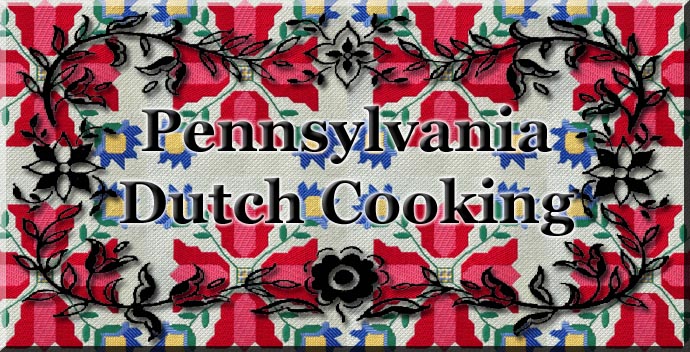|

PENNSYLVANIA Dutch COOKERY
In 1683 the Plain Sects began to arrive in William Penn’s Colony seeking
a land of peace and plenty. They were a mixed people; Moravians from
Bohemia and Moravia, Mennonites from Switzerland and Holland, the
Amish, the Dunkards, the Schwenkfelds, and the French Huguenots. After
the lean years of clearing the land and developing their farms they established
the peace and plenty they sought. These German-speaking people were
originally called the Pennsylvania Deutsch but time and custom have caused
them to be known to us as the Pennsylvania Dutch.
The Pennsylvania Dutch are a hard working people and as they say,
“Them that works hard, eats hearty.” The blending of recipes from their
many home lands and the ingredients available in their new land produced
tasty dishes that have been handed down from mother to daughter for
generations. Their cooking was truly a folk art requiring much intuitive
knowledge, for recipes contained measurements such as “flour to stiffen,”
“butter the size of a walnut,” and “large as an apple.” Many of the recipes
have been made more exact and standardized providing us with a regional
cookery we can all enjoy.
Soups are a traditional part of Pennsylvania Dutch cooking and the Dutch
housewife can apparently make soup out of anything. If she has only milk
and flour she can still make rivel soup. However, most of their soups are
sturdier dishes, hearty enough to serve as the major portion of the evening
meal. One of the favorite summer soups in the Pennsylvania Dutch country
is Chicken Corn Soup. Few Sunday School picnic suppers would be considered
complete without gallons of this hearty soup.
Many of the Pennsylvania Dutch foods are a part of their folklore. No
Shrove Tuesday would be complete without raised doughnuts called
“fastnachts.” One of the many folk tales traces this custom back to the
burnt offerings made by their old country ancestors to the goddess of spring.
With the coming of Christianity the custom became associated with the
Easter season and “fastnachts” are eaten on Shrove Tuesday to insure living
to next Shrove Tuesday. Young dandelion greens are eaten on Maundy
Thursday in order to remain well throughout the year.
The Christmas season is one of the busiest times in the Pennsylvania
Dutch kitchen. For weeks before Christmas the house is filled with the
smell of almond cookies, anise cookies, sandtarts, Belsnickle Christmas
cookies, walnut kisses, pfeffernusse, and other traditional cookies. Not just
a few of one kind but dozens and dozens of many kinds of cookies must be
made. There must be plenty for the enjoyment of the family and many
holiday visitors.
Regardless of the time of the year or the time of the day there are pies.
The Pennsylvania Dutch eat pies for breakfast. They eat pies for lunch.
They eat pies for dinner and they eat pies for midnight snacks. Pies are
made with a great variety of ingredients from the apple pie we all know to
the rivel pie which is made from flour, sugar, and butter. The Dutch housewife
is as generous with her pies as she is with all her cooking, baking six
or eight at a time not one and two.
The apple is an important Pennsylvania Dutch food. Dried apples form
the basis for many typical dishes. Each fall barrels of apples are converted
into cider. Apple butter is one of the Pennsylvania Dutch foods which has
found national acceptance. The making of apple butter is an all-day affair
and has the air of a holiday to it. Early in the morning the neighbors gather
and begin to peel huge piles of apples that will be needed. Soon the great
copper apple butter kettle is brought out and set up over a wood fire. Apple
butter requires constant stirring to prevent burning. However, stirring can
be light work for a boy and a girl when they’re young and the day is bright
and the world is full of promise. By dusk the apple butter is made, neighborhood
news is brought up to date and hunger has been driven that much
further away for the coming winter.
Food is abundant and appetites are hearty in the Pennsylvania Dutch
country. The traditional dishes are relatively simple and unlike most regional
cookery the ingredients are readily available. Best of all, no matter who
makes them the results are “wonderful good.”
|

 Home
Home What's New
What's New Bible
Bible Photos
Photos Hiking
Hiking E-Books
E-Books Genealogy
Genealogy Profile
Free Plug-ins You May Need
Profile
Free Plug-ins You May Need
 Get Java
Get Java.png) Get Flash
Get Flash Get 7-Zip
Get 7-Zip Get Acrobat Reader
Get Acrobat Reader Get TheWORD
Get TheWORD

